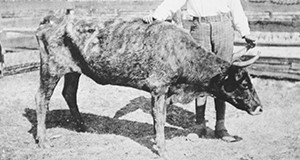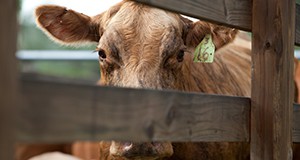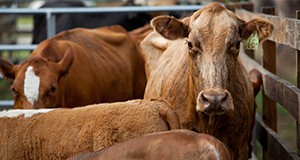 Culling decisions are important to maintain the productivity and profitability of the beef cow herd. Culling of cows from the herd eliminates poorly performing cows, inferior genetics, and cows with quality defects that would limit short- and long-term productivity. This 4-page fact sheet discusses reasons to cull as well as replacement of culled cows. Written by Matt Hersom, Todd Thrift, and Joel Yelich, and published by the UF Department of Animal Sciences, December 2015.
Culling decisions are important to maintain the productivity and profitability of the beef cow herd. Culling of cows from the herd eliminates poorly performing cows, inferior genetics, and cows with quality defects that would limit short- and long-term productivity. This 4-page fact sheet discusses reasons to cull as well as replacement of culled cows. Written by Matt Hersom, Todd Thrift, and Joel Yelich, and published by the UF Department of Animal Sciences, December 2015.
http://edis.ifas.ufl.edu/an323
Tag: livestock
Shrink in Beef Cattle: A Marketing Consideration
 Shrink in beef cattle is weight loss that occurs between an animal’s departure from one location and weigh-in at another. Shrink in beef calves constitutes a potential economic loss to both the seller and the buyer if it is not fully considered. This 3-page fact sheet discusses factors that affect shrink and the effects of shrink on calf price. Written by Matt Hersom, Todd Thrift, and Joel Yelich, and published by the UF Department of Animal Sciences, December 2015.
Shrink in beef cattle is weight loss that occurs between an animal’s departure from one location and weigh-in at another. Shrink in beef calves constitutes a potential economic loss to both the seller and the buyer if it is not fully considered. This 3-page fact sheet discusses factors that affect shrink and the effects of shrink on calf price. Written by Matt Hersom, Todd Thrift, and Joel Yelich, and published by the UF Department of Animal Sciences, December 2015.
http://edis.ifas.ufl.edu/an322
Risk Management for 4-H Youth Development Work: Large Animals: Livestock
 Most people involved in youth livestock exhibition are familiar with the physical risks of handling and transporting livestock, but public spectators generally need more instruction and supervision to ensure their safety and health. The Risk Management for 4-H Youth Development Work series aims to provide UF/IFAS Extension county faculty, staff, volunteers, and youth with the knowledge they need to implement best practices in risk management strategies. This 8-page fact sheet covers risks in the following categories: injuries to people, injuries to animals, property damage, biosecurity (diseases transmitted to humans and between animals), and general precautions. Written by Chad Carr, Saundra TenBroeck, Wendy DeVito, Chris Strong, Dale Pracht, and Georgene Bender, and published by the UF Department of Animal Sciences, November 2015.
Most people involved in youth livestock exhibition are familiar with the physical risks of handling and transporting livestock, but public spectators generally need more instruction and supervision to ensure their safety and health. The Risk Management for 4-H Youth Development Work series aims to provide UF/IFAS Extension county faculty, staff, volunteers, and youth with the knowledge they need to implement best practices in risk management strategies. This 8-page fact sheet covers risks in the following categories: injuries to people, injuries to animals, property damage, biosecurity (diseases transmitted to humans and between animals), and general precautions. Written by Chad Carr, Saundra TenBroeck, Wendy DeVito, Chris Strong, Dale Pracht, and Georgene Bender, and published by the UF Department of Animal Sciences, November 2015.
http://edis.ifas.ufl.edu/an321
Avian Diseases Transmissible to Humans
 Anyone who keeps birds, whether as pets or as production animals, should be aware that certain avian diseases can be transmitted to humans. The seriousness of the disease in humans varies with human hosts’ age, overall health, and immune status as well as virulence of the organism, infective dose, and route of infection. This 4-page fact sheet is a major revision which discusses causes and symptoms of avian influenza (bird flu), chlamydiosis, salmonellosis, colibacillosis, encephalitis viruses, avian tuberculosis, Newcastle Disease, and cryptosporidiosis. Written by Michael A. Davis, Gary D. Butcher, and F. Ben Mather, and published by the UF Department of Animal Sciences, revised August 2015. Original publication date: August 1997.
Anyone who keeps birds, whether as pets or as production animals, should be aware that certain avian diseases can be transmitted to humans. The seriousness of the disease in humans varies with human hosts’ age, overall health, and immune status as well as virulence of the organism, infective dose, and route of infection. This 4-page fact sheet is a major revision which discusses causes and symptoms of avian influenza (bird flu), chlamydiosis, salmonellosis, colibacillosis, encephalitis viruses, avian tuberculosis, Newcastle Disease, and cryptosporidiosis. Written by Michael A. Davis, Gary D. Butcher, and F. Ben Mather, and published by the UF Department of Animal Sciences, revised August 2015. Original publication date: August 1997.
http://edis.ifas.ufl.edu/ps019